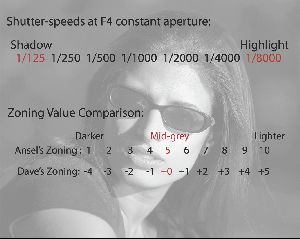articles/Lighting/lightingfordigital4-page3
Lighting for Digital 4 - part 3 of 1 2 3
by Dave Montizambert Published 01/10/2007

If our outdoor scenario had been different, let's say shot on a flat-lit cloudy day, we could expand the contrast on the film by exposing for the shadow, placing it at a darker value, in other words under-exposing the film relative to a grey-card reading, then pushing the underexposed highlight up higher in the scale by over processing (push processing). Push processing is when you leave the film in the developer longer than the recommended normal processing time so that the processing chemicals can penetrate deeper into the emulsion affecting the crystals that normal development would not have time to reach. A longer processing time has little or no affect on the shadow because light from the subject's shadow areas only effects the surface crystals which finish processing in a comparatively short time. Since there are no more lightaltered crystals from the shadow area to be developed, further time in the developer has no effect.
So that, in a nut-shell, is the B&W Zone System, and as you can see from what we just went over, exposing for the shadows is fairly involved. You don't just meter the shadow and set your camera at that setting, it is really about placing the shadow at a tone you want it to be in the final image and then placing the highlight or lit-side with processing time.
Looking at Image 05, if it were in colour it would be great, but I feel that for B&W it looks a little flat, and so reality is tossed out the door as I cheat with Photoshop and boost the contrast a little with Image 01 which makes the lit flesh tone over-exposed but I think better looking. B&W is not reality anyhow.
In the end the question still remains, should I expose for the shadows in digital? The answer is a big fat 'No', digital is much more touchy in the highlight end of the gray scale than is B&W film, so in reality we must do the opposite - we need to create exposures with the highlight in mind and only use an incident meter pointed at the camera lens in uncontrolled situations where you can only average the available light - more on this in the near future, and I promise if you will read my next article, no more false name-dropping.
Dave Montizambert lectures internationally on lighting, digital photography, and Adobe Photoshop. He is also a published author having written two books on lighting and digital photography (www. montizambert.com ) plus numerous magazine articles on these topics in North America, Europe, Russia and Asia. Dave also creates Photoshop tutorial CDs & DVDs for www.software-cinema.com . Dave is available for lectures and workshops in your area and can be reached at montizambert@telus.net or www.montizambert.com . Dave Montizambert owns and operates Montizambert Photography Inc. located in downtown Vancouver. For the past 25 years his company has created photographic images to aid various organisations and companies with their communication needs. He has created images for clients such as: McDonalds Foods, Motorola, Atlanta Scientific/ Nexus Engineering, Toyo Tires, Tri-Star Pictures, Warner Brothers, Constantine Films of Germany, Chevron Canada, Cuervo Tequila, the Canadian Broadcasting Corporation, J&B Scotch, Hong Kong Bank, Chimera Softboxes, B.C. Lottery Corp., Blackcomb & Whistler Mountains, Tsing Tao Brewery of China, B.C. Hot House, Kona Bikes, No Fear Sports Gear, Kodak, and Canada Post. His work has won Georgie, Lotus, Hemlock, Studio Magazine, CAPIC, and Graphex awards.
Please Note:
There is more than one page for this Article.
You are currently on page 3 Contact Dave Montizambert
1st Published 01/10/2007
last update 09/12/2022 14:55:49
More Lighting Articles
There are 0 days to get ready for The Society of Photographers Convention and Trade Show at The Novotel London West, Hammersmith ...
which starts on Wednesday 15th January 2025





